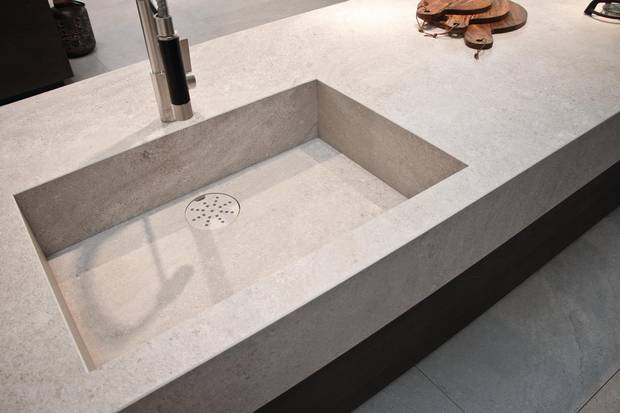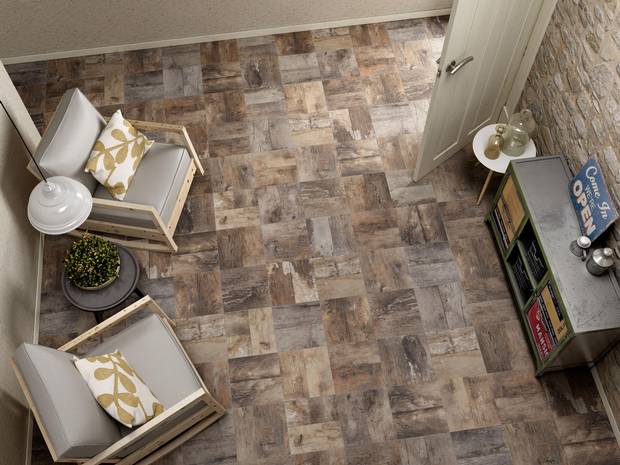Like faucets, doorknobs and sconces – tiles often get the shaft. They're an afterthought on the remodeller's to-do list, a bridesmaid to the spotlight-hogging soaker tub or countertop.
But such preconceptions of the humble material went the way of the dodo in Chicago last week at Coverings '16, North America's largest international stone and tile expo, where 1,100 international exhibitors gathered to show their wares to an estimated 23,000 visitors.
At the expo this year, there seemed to be no limit to what ceramic and porcelain could emulate or where it could be used – as a chic sub-in for a Calacutta marble countertop, sink and tub; in a statement wall of rustic "wood" planks; as the "concrete" floor of an industrial loft. "Tile is one of the greatest chameleons," said Ryan Fasan, the Vancouver-based technical consultant for Tile of Spain.
Several beguiling iterations at the show mimicked brick and fabric – at Ceramica Sant'Agostino's digital art display, you would swear you were looking at a swatch torn from a length of linen. Others convincingly resembled damask wallpaper, antique carpet and oxidized metal. It wasn't uncommon to see people running a hand over the ribbed "aluminum" tiles by Diesel for Living in collaboration with Iris Ceramica to see if it wasn't real, or stroking the ersatz quartz that glinted from a faux patio stone by La Faenza.
The leather-like Verve tiles by Cerodomus Ceramiche bring warmth to a room.
Technology clearly plays a role in such innovations and creating richer and more varied tile hues. "Most of the amazing chameleon features on tile is directly related to ink-jet printing capabilities," Fasan said. "Nowadays between what we can do with texture during pressing and then digital decoration of the tile, we can create the most realistic stones, woods or metals."
Other technological breakthroughs add metallic finishes and specialty glazes. The tiles are designed on "a giant Photoshop file," he explains, estimating that 75 per cent of the patterned tiles at the show were created digitally.
Tech tiles, which were first unveiled at Cevisama, the Spanish trade show, in 2000, have come a long way and, in some cases, pragmatism is driving innovation.
Featuring faint lines that recall foolscap, Ornamenta’s playful Paper collection for walls and floors has a chalkboard surface you can write on. The porcelain tiles come in white, grey and black.
In the kitchen, ceramic tile can take the heat of a hot pot and won't damage or discolour, explained Fasan. "All of a sudden, a red-wine drinker or a heavy cook who wants Carrera marble has options."
The same thinking applies to an oak-look bathroom tile ("humidity and water exposure wouldn't work for natural wood but tile reproductions do," Fasan said) or a highly trafficked kitchen, where hardwood isn't the greatest option because kids, pets and spills will give it a bashing.
Gunnar Larson, a New York-based interior designer known for his crisp white eclectic spaces layered with texture and colour, attended Coverings. He was drawn to tiles that replicated salvaged wood. "My clients love the look of reclaimed wood but not that it can splinter, feel rough to walk on barefoot and is hard to clean, especially in the kitchen," Larson said.

Ceramic tiles in Inalco’s Petra series in crema from the iTopker collection can be fashioned into an elegant sink and countertop that resemble limestone.
Wood tile is exciting, he continued, especially now that the digital grain is so authentic-looking and the planks are longer. "Plus, there are less chemicals than in pre-finished wood floors so tile is an eco-friendly alternative," Larson said.
So, what to make of all this imitation? According to Martin Bechthold, a Coverings attendee and professor of architectural technology at Harvard University's Graduate School of Design, ceramic mimicry is actually not that new.
"In architectural cladding there is a long history of ceramics being a chameleon. In the United States, at the end of the 19th century we had the beginning of high-rise buildings and they needed fireproofing; they really wanted the look of stone," Bechthold said.
The two walls and sink here, tiled in Kronos by Saloni Ceramica, look like they are made of embossed concrete.
"A lot of these buildings are actually ceramics. … One of the most wonderful is Adler and Sullivan's Guaranty Building in Buffalo, New York, with its intricate terracotta façade."
Still, Bechthold acknowledged digital ink-jet printing is interesting because it signals a shift, a bringing to light of a previously behind-the-scenes industry. "The more profound trend is the tendency for the mass producers to move a little closer to the customer," he says, likening the highly individualized customization to what's happening with shoes or clothing.
Instead of picking tile from a catalogue, an interior designer or architect could upload an original image – maybe an intriguing close-up of an avocado peel or a shot of a forest – that is reproduced onto small tiles or massive cladding.
"The owner can have a unique tile in their building, individualized for their aesthetic needs," Bechthold said.
For a long time tile artisans "were producing what they thought the market wanted. But they actually didn't know. Now they have a connection to the market, especially in Spain, where there has been a lot of investment and development of the ink-jet printing technology," Bechthold said.
"Handmade tiles lack the precision and quality that comes with industrialized methods of production – now you take a tile and pretty much put anything you want on it."
